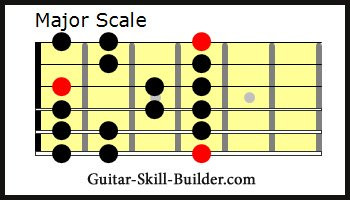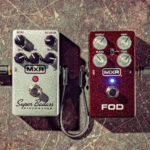Unlock the secrets of the fretboard and elevate your guitar playing with our comprehensive guide to guitar scales. Understanding and practicing scales is fundamental for any guitarist looking to improvise, write compelling solos, or simply expand their musical vocabulary. Each scale possesses a unique character and sonic flavor, offering a diverse palette for musical expression. Explore these essential scales and modes to discover new sounds and enhance your connection with your instrument.
Ready to dive in?
Click here to Download your Free Guitar Scales Chart PDF.
Guitar Scales Chart
1. Major Guitar Scale
The Major scale stands as the cornerstone of Western music theory, serving as the foundation for countless other scales and modes. Its bright, cheerful sound is instantly recognizable and widely used across genres. By simply rearranging the notes within the Major scale, you can unlock a spectrum of different moods and musical textures.
Characterized by its upbeat and happy feel, the Major guitar scale is a staple in diverse musical styles, including Rock, Country, Pop, and Folk. Its versatility shines through as its character subtly shifts when paired with different chord progressions and rhythmic patterns.
[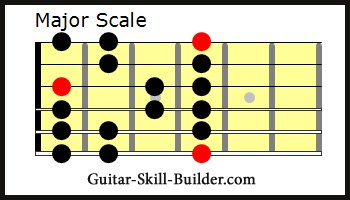 Major Scale Diagram
Major Scale Diagram
2. Dorian Mode Guitar Scale
Step into the realm of jazz and blues with the Dorian mode. This minor scale variation introduces a slightly jazzy and melancholic flavor, making it a favorite among improvisers and songwriters seeking a touch of sophistication.
The Dorian mode distinguishes itself with a minor feel that is less overtly sad than the natural minor, offering a modal sound often described as introspective or contemplative. It’s a powerful tool for adding depth and emotion to your guitar playing, particularly in jazz, blues-rock, and fusion.
[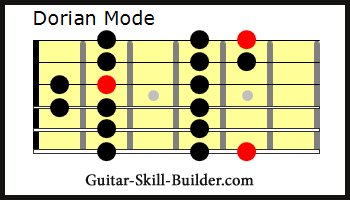 Dorian Mode Diagram
Dorian Mode Diagram
3. Phrygian Mode Guitar Scale
For a dramatic and exotic flair, explore the Phrygian mode. This scale evokes a Spanish or flamenco vibe, imbued with a sense of mystery and intensity. It’s a compelling choice for adding a unique and memorable sound to your guitar work.
The Phrygian mode’s distinctive sound stems from its characteristic minor second interval, creating a dark and almost haunting quality. It’s often used in metal, flamenco, and world music to create dramatic and emotionally charged passages. Experiment with this mode to inject a dose of passion and intrigue into your playing.
[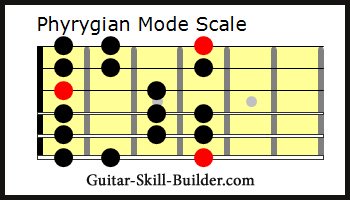 Phrygian Mode Diagram
Phrygian Mode Diagram
4. Lydian Mode Guitar Scale
The Lydian mode opens up a world of airy and ethereal sounds. Often described as dreamy or uplifting, this major scale variant possesses a unique quality that can add a touch of magic to your music. Many guitarists enjoy using reverb and delay effects to further enhance the Lydian mode’s spacious character.
The Lydian mode stands out due to its raised fourth degree, lending it a bright, suspended, and almost otherworldly quality. It is frequently employed in jazz fusion, progressive rock, and film scores to create expansive and emotionally evocative textures.
[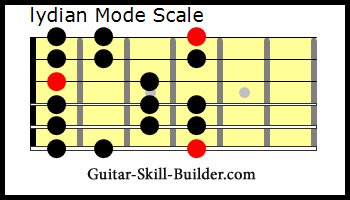 Lydian Mode Diagram
Lydian Mode Diagram
5. Mixolydian Mode Guitar Scale
If you’re aiming for a bluesy, roots-rock, or country feel, the Mixolydian mode is your go-to scale. This dominant scale mode carries a strong blues and rock and roll flavor, perfect for creating catchy riffs and solos.
The Mixolydian mode is essentially a Major scale with a flattened 7th, giving it a dominant and bluesy edge. It’s widely used in blues, rock, country, and funk music. Its characteristic sound is ideal for soloing over dominant 7th chords and creating a classic, timeless vibe.
[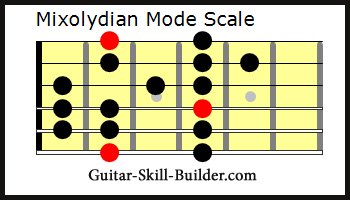 Mixolydian Mode Diagram
Mixolydian Mode Diagram
6. Melodic Minor Guitar Scale
For a sophisticated and jazzy sound, delve into the Melodic Minor scale. This scale is synonymous with jazz improvisation and composition, offering a smooth and flowing melodic quality. It’s a favorite among jazz musicians seeking a refined and articulate sound.
The Melodic Minor scale is unique in that it has different ascending and descending forms, though the ascending form is most commonly used for improvisation. It possesses a rich, harmonic complexity that makes it perfect for jazz, fusion, and classical music.
[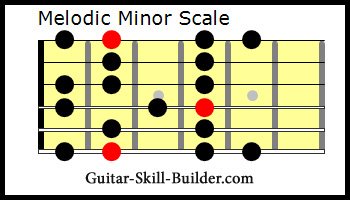 Melodic Minor Scale Diagram
Melodic Minor Scale Diagram
7. Whole Tone Guitar Scale
Venture into dissonance and explore the unique sound of the Whole Tone scale. This scale, composed entirely of whole steps, creates a floating, ambiguous, and sometimes unsettling sound. It’s an excellent choice for adding a touch of the avant-garde to your playing.
The Whole Tone scale’s lack of a clear tonal center gives it a dreamlike, unresolved quality. It is often used in impressionistic music, jazz, and film scores to create a sense of mystery, tension, or otherworldliness.
[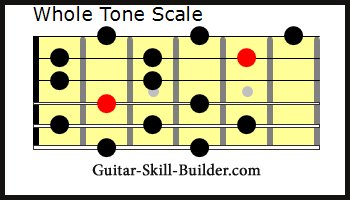 Whole Tone Scale Diagram
Whole Tone Scale Diagram
8. Diminished Guitar Scale
Inject a dose of heavy metal intensity into your playing with the Diminished scale. This scale’s tense and angular sound is well-suited for aggressive and dramatic musical styles. It can evoke a sense of unease or even chaos, making it a powerful tool for heavy and progressive music.
The Diminished scale, in its most common form (Whole-Half Diminished), alternates whole and half steps, creating a symmetrical and dissonant sound. It’s a staple in heavy metal, fusion, and contemporary classical music for creating tension, drama, and a sense of the unexpected.
[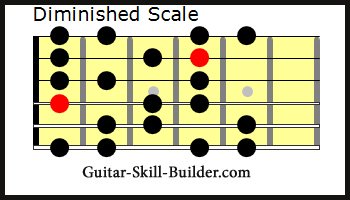 Diminished Scale Diagram
Diminished Scale Diagram
9. Major Pentatonic Guitar Scale
For a bright and cheerful country sound, look no further than the Major Pentatonic scale. This five-note scale is incredibly versatile and easy to use, particularly in country, folk, and rock music. Its simplicity and positive vibe make it a favorite for melodic playing.
The Major Pentatonic scale is derived from the Major scale by omitting the 4th and 7th degrees, resulting in a consonant and open sound. It’s a cornerstone of country, blues, rock, and pop music, prized for its melodic simplicity and bright, optimistic character.
[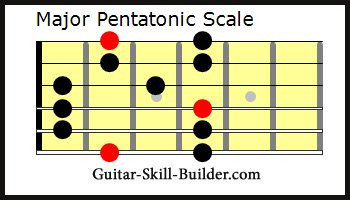 Major Pentatonic Scale Diagram
Major Pentatonic Scale Diagram
10. Minor Pentatonic Guitar Scale
The Minor Pentatonic scale is the bedrock of blues and rock guitar. Its bluesy and soulful sound is instantly recognizable and essential for any guitarist exploring these genres. Adding effects like distortion, reverb, and delay can further transport you to the heart of blues and rock traditions.
The Minor Pentatonic scale, like its major counterpart, is a five-note scale, derived from the minor scale by omitting the 2nd and 6th degrees. It’s the quintessential blues and rock scale, known for its expressive and soulful character, perfect for bending notes and creating classic blues licks.
[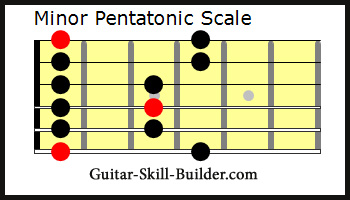 Minor Pentatonic Scale Diagram
Minor Pentatonic Scale Diagram
11. Locrian Mode Guitar Scale
The Locrian mode is the darkest and most dissonant of the diatonic modes. Its sinister and unsettling sound makes it suitable for heavy metal and creating suspenseful or dramatic musical passages. While less commonly used for melodic improvisation in mainstream genres, it can be effective for creating unique textures and atmospheres.
The Locrian mode is characterized by a diminished triad built on its root, making it harmonically unstable and dissonant within a traditional diatonic context. It is sometimes used in heavy metal, experimental music, and film scores to create a sense of unease, tension, or darkness.
[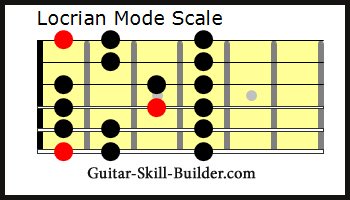 Locrian Mode Diagram
Locrian Mode Diagram
12. Aeolian Mode Guitar Scale – Natural Minor Scale
The Aeolian mode, also known as the Natural Minor scale, embodies a melancholic and introspective mood. Its sad yet gentle character makes it ideal for expressing a range of emotions, from subtle sadness to quiet contemplation.
The Natural Minor scale is characterized by its minor tonality, creating a somber and reflective atmosphere. It’s a fundamental scale in Western music, used extensively in classical, folk, pop, and rock music to convey a wide range of minor key emotions.
[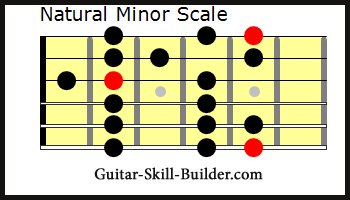 Aeolian Mode Diagram
Aeolian Mode Diagram
13. Harmonic Minor Guitar Scale
The Harmonic Minor scale adds a touch of classical elegance and drama to the minor sound. Its unique interval structure, featuring an augmented second, creates a distinctive and somewhat exotic flavor. It’s a great choice for classical rock, neoclassical metal, and adding a sophisticated edge to your minor key compositions.
The Harmonic Minor scale is created by raising the 7th degree of the Natural Minor scale, resulting in a characteristic augmented second interval between the 6th and 7th degrees. This gives it a distinctive, dramatic, and often described as “Spanish” or “Middle Eastern” sound, used in classical music, flamenco, and metal genres.
[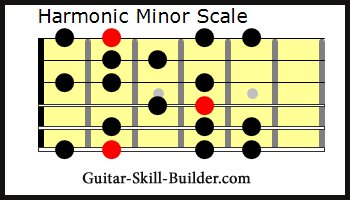 Harmonic Minor Scale Diagram
Harmonic Minor Scale Diagram
14. Minor Blues Guitar Scale
The Minor Blues scale is the definitive scale for blues improvisation. It expands upon the Minor Pentatonic scale by adding a “blue note,” further intensifying its bluesy character. Mastering this scale is essential for any guitarist seeking to authentically capture the blues sound.
The Minor Blues scale takes the Minor Pentatonic scale and adds a flattened 5th (or augmented 4th), the “blue note,” creating the quintessential blues sound. This added note provides extra grit and expressiveness, making it ideal for blues, blues-rock, and any style where you want to inject a bluesy feel.
[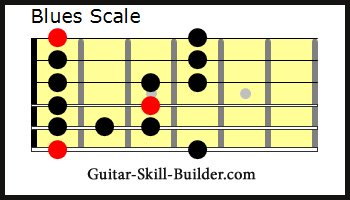 Minor Blues Scale Diagram
Minor Blues Scale Diagram
| Roy Barnett, webmaster, guitar-skill-builder.com Connect with Roy on Google+ | Welcome to guitar-skill-builder.com Reviews of beginner guitar lessons and tools to help you master the guitar. Full sitemap here |
|---|

